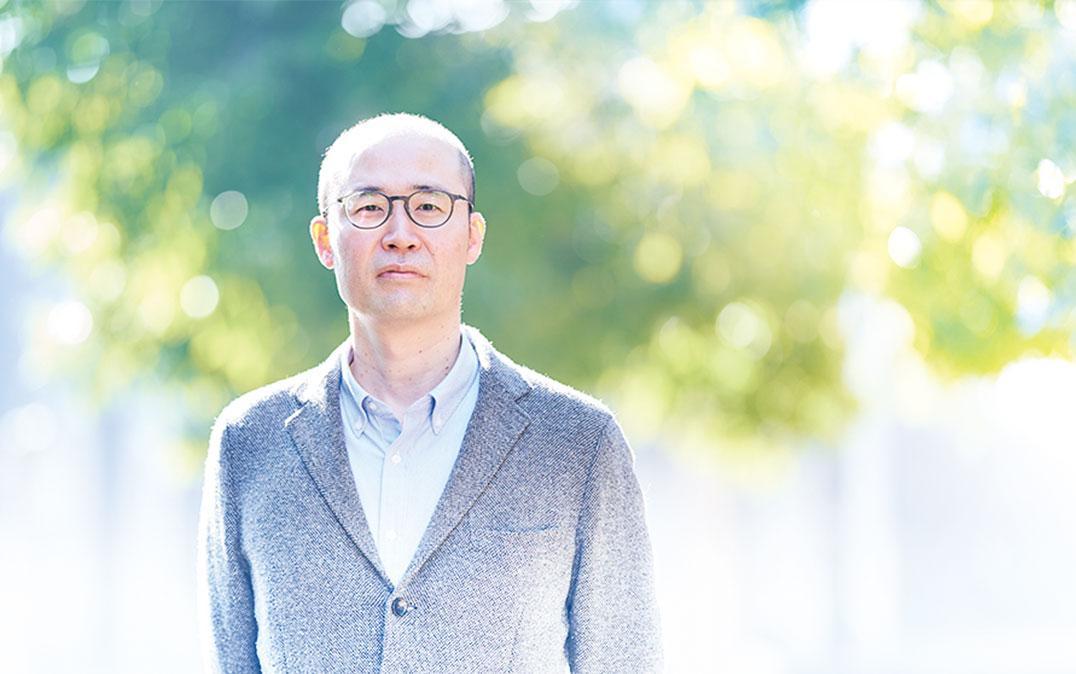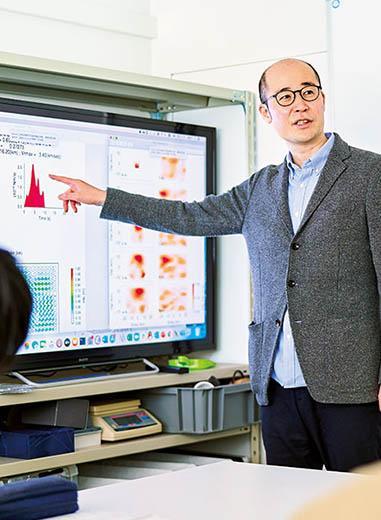TSUKUBA FRONTIER
#033 What's Happening at the Source of Earthquakes?: The Challenge of Understanding Earthquake Diversity
Professor YAGI Yuji, Faculty of Life and Environmental Sciences

Although theories such as plate tectonics can more or less explain the mechanism of earthquakes, understanding the diversity of earthquake phenomena is not an easy task. The reason for this diversity is the complexity of the Earth's internal structure. Even the highest performance computers cannot eliminate error from the analysis of seismic observation data. It is impossible to know everything about the Earth. Based on this premise, Professor Yagi is applying new ideas and researching methods of analysis to gain a more accurate understanding of earthquakes.
The Extremely Complex Mechanism of Earthquakes
It is well known that earthquakes are caused by the movement of bedrock (plates) on the Earth's surface and by the displacement of faults, but no two earthquakes that we actually experience are the same. Fault slip distribution is not uniform, the slip direction and shape of the faults vary widely, and the way seismic waves are transmitted can also differ depending on the structure of the Earth's interior.
The only information we can access directly about earthquakes is the data observed on the surface of the Earth. As for what is actually happening at the source of the earthquake, we can only conjecture based on observed data. With this observed data, in order to get the most accurate assessment of the form of an earthquake, we need the right kind of model and analysis method to indicate the rupture process along the fault zone. While there are somewhat established models and methods available, high-quality observation data has revealed that earthquakes are in fact more complex and diverse than previously thought. There is the increasing belief that conventional models and methods are no longer adequate for tracking this degree of complexity.
Approaches taken by many researchers of seismic activity seek to research and model the structure of the Earth's interior as precisely as possible. They attempt to analyze the faults that move during earthquakes with the most complex models possible. This research style is the standard in the field. However, this method includes the use of massive parameters and inevitably relies on considerable funding and staffing to just barely power the research to reach findings. The fact of the matter is that it is extremely difficult to research and model all things involved.
Leave the Unknowns Unknown
But this does not justify just giving up. Prof. Yagi decided to get away from trying to define parameters beyond his means and instead proposed the idea of constructing a new analysis method. This approach was predicated on accepting that unknown parameters would continue to be unknown.
This analysis method was a breakthrough in the field of seismic wave analysis because it clarified what kind of error results from not having a complete knowledge of the structure of the Earth's interior, while also suggesting methods for reducing the effect of this error. Up until that point, the standard practice in the field had been to power our way through the process to eliminate such error as much as possible. In response, Prof. Yagi's idea was that analysis could be made easier if we just accepted the notion that the Earth's interior cannot be completely modeled. By processing the error statistically and incorporating it into modeling, it became possible to more effectively describe the actual phenomena that occurred.
He proposed this analysis method in 2011. Initially, he was the sole front-runner, but as the effectiveness of the method was recognized, more and more researchers started to collaborate. This led to the actual method undergoing improvements, and now the approach that he proposed has gone on to become a kind of benchmark in the field. Once a new path has been carved out, the temptation is to continue down that path, but Prof. Yagi finds that his own instinct is to instead create yet another new path. Now, he is preparing to propose an analysis method that is almost the exact opposite of the approach he proposed before. The act of proposing a new approach is also a strategy to make effective use of limited research resources.
The Great Hanshin Earthquake Was the Catalyst
The area around Kamaishi City in Iwate Prefecture, where Prof. Yagi spent his childhood, has been hit by tsunamis many times in the past. So, even as far back as his elementary school days, there were many classes about earthquakes and tsunamis as well as robust education about disaster preparedness. This prompted his interest in earthquakes. The Great Hanshin Earthquake that he experienced when he was a university student was the catalyst that prompted him to turn his mere interest into a subject of research to pursue. It was a quake that shook over only a short period of time but devastated an entire region, a fact that both shocked and, at the same time, aroused a desire to find out why such a phenomenon occurred and what was happening at the hypocenter of the quake.
The first thing Prof. Yagi worked on upon becoming a researcher was to create what he would call a "catalog of earthquakes." He believed that a new catalog of earthquakes, describing how earthquakes occur and develop, would advance our understanding about earthquakes and give us profiles of standard earthquakes, which would make it possible to identify unusual earthquakes. In reality, however, the attempt to analyze all earthquakes with a single method did not yield adequate results. The researchers at that time analyzed each earthquake using their own fault models and analysis methods. This meant that the form of a single earthquake could look different depending on the researcher. In the absence of a robust analysis method that can be applied to all earthquakes and produce consistent results, it is not possible to create a catalog that describes what happened in a given earthquake.
In the midst of all this, it dawned upon Prof. Yagi that he could just let the unknowns stay unknown. This was the idea that propelled his research back into motion.
Quicker and More Refined

In recent years, Japan has been frequently experiencing large earthquakes, but even these earthquakes are categorized as somewhat too small in scale to be analyzed. Large earthquakes with a magnitude of 8 on the Richter scale provide plentiful data and are the most suitable for analysis. Since earthquake data from all over the world is publicly available and can be used by anyone, success in achieving research results in this field is contingent on how quickly you can produce results after an earthquake, and how refined the analysis method is. Of course, it is also important to integrate the results with other information in order to reveal what the earthquake actually is.
While there is a lot of information that needs to be obtained in data analysis, any attempt at yielding large amounts of information in a single calculation makes for vague results. Also, if the calculations are on a scale that requires the use of a supercomputer, the research might not progress as quickly as expected due to having to wait for the equipment to become available. These are the contingencies one must take into consideration as one refines their analysis method so that it is as simple as possible but also efficient.
Once Again Striving toward the Creation of an Earthquake Catalog
Another subject Prof. Yagi is working on is the analysis of earthquakes that occur at depths 600 to 700 km underground. At deep earthquakes, faults shift in a world of ultra-high pressure, generating enormous frictional heat. In addition, there are phenomena not observed in more shallow earthquakes, with causes that are unclear. In such cases, conventional analysis methods are useless. Prof. Yagi is trying to develop more versatile analysis methods that can facilitate an understanding of earthquakes at various depths.
From the perspective of the Earth, earthquakes are really just very small changes. But those small changes are important to us. Some people might assume that earthquake research is all about predicting and forecasting. And yet, even with an observation network that has become quite extensive and the attendant insights available, predicting and forecasting quakes continue to be tasks that are next to impossible. Instead, analysis of seismic activity that is as accurate as possible and the accumulation of the consequent results make visible the patterns of earthquakes in each region. This serves as important information for considering in advance what measures to take after earthquakes occur and what rescue systems to have in place.
Toward this end as well, there is a need for a catalog that lists methods for analyzing all kinds of earthquakes while also listing the forms of earthquakes as derived from the results of analyses. The ultimate goal of Prof. Yagi's work as a researcher is to develop a method of analysis that becomes the standard for his field and to complete an earthquake catalog.
(Lab website: https://www.geol.tsukuba.ac.jp/~yagi-y/eng/index.html)

Article by Science Communicator at the Office of Public Relations


